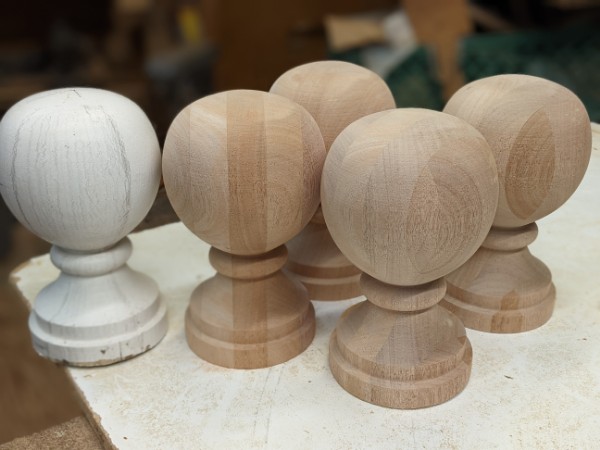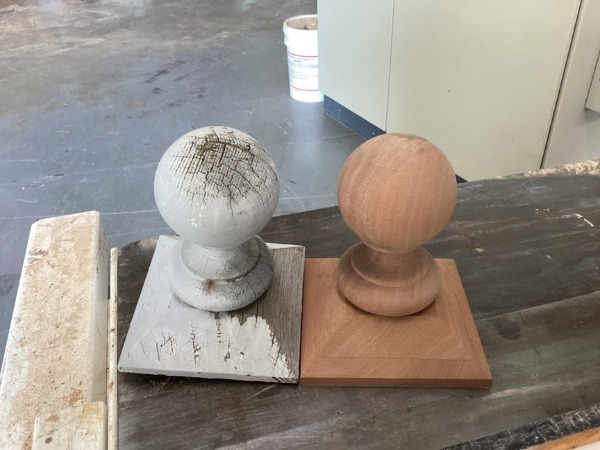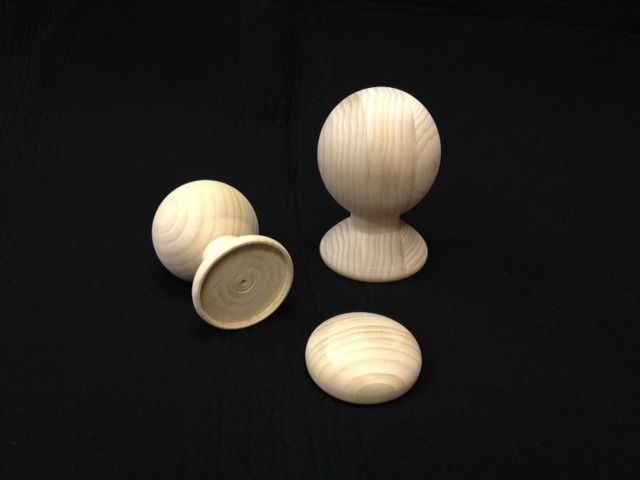What to Know at a Glance
A Simple Definition of a Finial
A finial is a decorative or ornamental piece that marks the very top or end of an object. In simple terms, it’s a “cap” or finishing touch that makes something look complete. The word “finial” comes from the Latin finis, meaning “end,” because a finial usually signifies the end point of an object.
Finials are often added to everyday items and structures to make them more attractive. For example, you can find them on furniture, curtain rods, lamps, and even on the tops of buildings.

Custom Mahogany Finials – Matched to Customer Sample for Architectural Projects
Handcrafted mahogany finials, reproduced from a customer sample for custom woodworking projects.
Common Types of Finials & Where They’re Used
These wood pieces come in many shapes and sizes, and they serve different purposes around the home and in architecture. Some are very simple, while others are elaborate and eye-catching. No matter the type, all of them act as a finishing detail that makes an object look complete and decorative.
Finials can be found in all sorts of places. Below are some common types and where you might see them.
Architectural versions are usually the most noticeable type of finial. As an example, the famous Taj Mahal in India has a bronze finial perched on the top of its main dome. It sits over 30 feet tall and was originally made of gold, serving as the “crown” of the building’s design. It doesn’t hold anything up or cover anything; it simply shows off the importance of that building’s highest point. In general, they often become a signature part of a design.
Finials vs. Caps vs. Knobs – What’s the Difference?
It’s easy to confuse finials with other end pieces like caps or knobs, but they do have differences. A cap is usually a plain cover for the end of a post or rod – its job is mostly to protect the end or give it a finished look. Caps tend to be smooth, flat, or simple in design and don’t draw much attention. For example, a flat wooden plug on the top of a fence post is a cap.
A knob, on the other hand, is usually a functional handle or a simple rounded piece that you grab or turn (like a door knob or a drawer knob). Knobs can be decorative, but they are primarily made to be touched and used. Finials are different because their main purpose is to decorate and enhance the appearance of the object’s end point. You typically don’t grab or turn a finial (except perhaps a lamp finial when unscrewing it). In fact, the same stair post might have a newel cap if it’s plain, but an ornate one is called a newel finial if it’s highly decorative.
To summarize, a finial is like an ornamental crown for an object, whereas caps and knobs are usually simpler and more about function than flair.

Sapele Newel Post Cap Reproduction Beside Aged Sample
Reproduced sapele newel post cap shown next to the original customer-supplied sample for comparison.
What Are Finials Made Of?
As we mentioned earlier, finials can be made from various materials depending on what you need them for and how you want them to look. Below are a few common materials and where they are often used.
Can These Pieces Be Customized?
Absolutely! Finials are often the design detail that designers and builders especially want to get just right. Thankfully, companies like ours offer full customization! You can have them made in any shape, size, or style you need.
For example, a carpenter or manufacturer can create them to match a unique furniture design or an architectural theme. They will turn or carve the wood to the precise dimensions and even choose the wood species you prefer (oak, maple, cherry, etc.).
The same goes for metal. A metalworker can cast a custom shape or logo into a finial if needed. You can also specify the finish. You might want a finial painted in a certain color, stained to match other woodwork, or plated with a specific metal coating.
Ordering a custom finial usually involves providing a drawing or example of the design you want. Manufacturers can then produce that design, especially if you need many identical components for a project. This is common in restoration projects (to replicate old versions) or in large-scale builds. With modern tools and machines, very intricate finial designs can be made reliably!
Need custom wood pieces for your production run or architectural project? Request a quote!

Custom Poplar End Cap Finials
Small poplar ball finials and one poplar cap finial designed for custom architectural and furniture applications. These finials can be customized in different sizes and wood species.
Final Thoughts: Small Details, Big Impact
Finials are considered to be small details that have a big impact on design. They tie together the overall look of furniture, window treatments, or architecture, and a well-chosen finial shows that someone paid attention to the finishing touches. The right finial offers completeness and style to a project and proves that sometimes the smallest pieces have the biggest impact.
Let’s Get Started on Your Custom Order
If you’re ready to begin production on the perfect wood finial(s) to match your desired decor scheme, reach out to us to learn more about our process. We’ll talk you through each step and provide you with a free, no-obligation estimate. Contact us today to see why we’ve been the best in the business for over 100 years!
